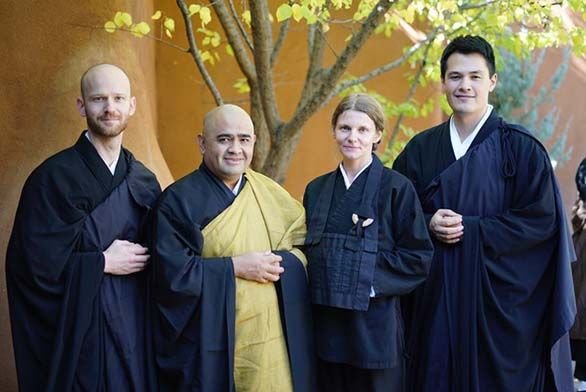Johnnies Find Each Other at Santa Fe’s Upaya Zen Center
April 9, 2019 | By Eve Tolpa

Just about every professional sector of Santa Fe is populated with St. John’s alumni, but one organization seems to have a higher than average percentage of Johnnies on staff: Upaya Zen Center. Of the dozen or so employees at the nonprofit, five are Santa Fe alumni—Communications and Donor Services Manager Melissa White (SF87), Bookkeeper/Gift Entry Administrator Richard Shcolnik (SF85), Director of Finance and Operations Ellen Stevens (EC99), Marketing Associate/Assistant to Abbot Noah Rossetter (SF07), and President/Resident Director Matt Palevsky (SFGI17).
“We do everything from housing and training a resident body of 12 to 20 individuals, who live and work and practice at Upaya, to hosting 43 programs a year,” explains Palevsky. “I am responsible for the day-to-day administration of Upaya’s many endeavors in the world.”
“We have a resident body of practitioners, and we have a staff body,” says Rosseter. Maintaining a Zen practice is not a prerequisite for working on staff at Upaya, but he and Rossetter do so—and they are also ordained priests.
“Becoming ordained is a process of mutual decision with a teacher,” Palevsky says, noting another requirement: “You sew by hand the robe you are going to wear.” It’s a process that takes roughly 200 hours, time than can be spent reflecting on the meaning of a life of service.
Palevsky came to Santa Fe in 2014 to join the Zen center as a resident and was “astounded by my luck that I ended up a mile away from St. John’s.” His father had attended University of Chicago in the 1940s and hoped Palevsky would follow in his academic footsteps. Although Palevsky chose Brown University instead, he had been instilled with a lifelong appreciation for classical education, which ultimately led him to enroll in the Graduate Institute’s Master of Arts in the Liberal Arts (MALA) program.
“There’s a kind of luxury and a wisdom you get from reading the canon,” he says. “The value of the program for me was inextricable from its culture, particularly the culture of slowing down, of reading everything twice, and coming into discussion about these rich texts from a place of humility and curiosity, learning from both the texts and from each other. I had studied philosophy as an undergrad, but I had never been so comprehensive in my reading.”
For Rossetter, who first encountered the great books curriculum while growing up in Anchorage, Alaska, the initial attraction to St. John’s was that it offered “something totally different that got to the root of philosophy.”
“I had the sense of wanting to know what’s really going on, what’s the truth of things,” he says. “I did my senior thesis on Nietzsche’s Thus Spake Zarathustra, and there are a lot of spiritual elements in that.”
Palevksy and Rosseter see a number of similarities between Upaya and St. John’s.
“What’s the same about [the two organizations] is what I appreciate about St. John’s—the close and rigorous examination of your life,” says Rossetter. For him, Zen Buddhism represents a continuation of that process, with the scrutiny instead directed inward, toward one’s own mind. “In Zen, it’s like the ultimate truth is that there is no ultimate truth.”
Palevsky believes that Santa Fe itself plays a big role in the appeal of the two organizations, both of which he sees as contextualized by their geography.
“Throughout history, people have gone to the desert to quiet their minds and investigate their minds in solitude and silence,” he explains. “There’s a beauty to this land that’s wild and vast that’s simply absent in an urban environment.”
While there is no formal relationship between St. John’s and Upaya, some Johnnies do attend the Wednesday dharma talks at the center. Rossetter thinks, however, that the connection could be stronger and more explicit.
“I actually would like to see more outreach to St. John’s,” he says.
“These two institutions are about creating a refuge and an educational environment in which to better ourselves and to look at ourselves,” Palevsky says. “I think my Zen Buddhist practice gave me an appreciation for the process over product. At St. John’s, I saw that could be enacted in a different environment. The value of a seminar or tutorial discussion was not in its brilliance, but in how I showed up for it and how we all made music together.”
Working alongside Johnnies, he continues, “is really great. There’s a shared lexicon and quality of curiosity and approach to problem solving and understanding that is not about being an expert, but about being in a process of discovery together, no matter what we are doing. There’s really a way in which Johnnies have undergone an experience that’s indelible. I’m continually surprised and not surprised that we find each other wherever we go.”

